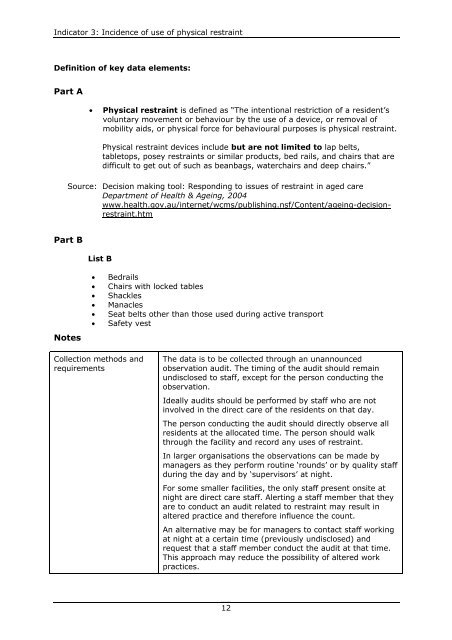Resource Manual For Quality Indicators In - Department of Health
Resource Manual For Quality Indicators In - Department of Health
Resource Manual For Quality Indicators In - Department of Health
You also want an ePaper? Increase the reach of your titles
YUMPU automatically turns print PDFs into web optimized ePapers that Google loves.
<strong>In</strong>dicator 3: <strong>In</strong>cidence <strong>of</strong> use <strong>of</strong> physical restraint<br />
Definition <strong>of</strong> key data elements:<br />
Part A<br />
• Physical restraint is defined as “The intentional restriction <strong>of</strong> a resident’s<br />
voluntary movement or behaviour by the use <strong>of</strong> a device, or removal <strong>of</strong><br />
mobility aids, or physical force for behavioural purposes is physical restraint.<br />
Physical restraint devices include but are not limited to lap belts,<br />
tabletops, posey restraints or similar products, bed rails, and chairs that are<br />
difficult to get out <strong>of</strong> such as beanbags, waterchairs and deep chairs.”<br />
Source: Decision making tool: Responding to issues <strong>of</strong> restraint in aged care<br />
<strong>Department</strong> <strong>of</strong> <strong>Health</strong> & Ageing, 2004<br />
www.health.gov.au/internet/wcms/publishing.nsf/Content/ageing-decisionrestraint.htm<br />
Part B<br />
List B<br />
Notes<br />
• Bedrails<br />
• Chairs with locked tables<br />
• Shackles<br />
• Manacles<br />
• Seat belts other than those used during active transport<br />
• Safety vest<br />
Collection methods and<br />
requirements<br />
The data is to be collected through an unannounced<br />
observation audit. The timing <strong>of</strong> the audit should remain<br />
undisclosed to staff, except for the person conducting the<br />
observation.<br />
Ideally audits should be performed by staff who are not<br />
involved in the direct care <strong>of</strong> the residents on that day.<br />
The person conducting the audit should directly observe all<br />
residents at the allocated time. The person should walk<br />
through the facility and record any uses <strong>of</strong> restraint.<br />
<strong>In</strong> larger organisations the observations can be made by<br />
managers as they perform routine ‘rounds’ or by quality staff<br />
during the day and by ‘supervisors’ at night.<br />
<strong>For</strong> some smaller facilities, the only staff present onsite at<br />
night are direct care staff. Alerting a staff member that they<br />
are to conduct an audit related to restraint may result in<br />
altered practice and therefore influence the count.<br />
An alternative may be for managers to contact staff working<br />
at night at a certain time (previously undisclosed) and<br />
request that a staff member conduct the audit at that time.<br />
This approach may reduce the possibility <strong>of</strong> altered work<br />
practices.<br />
12
















